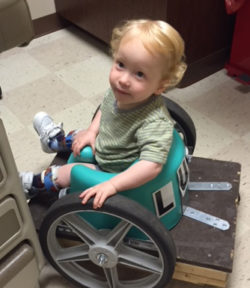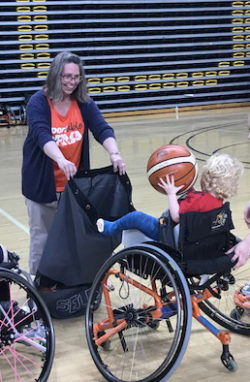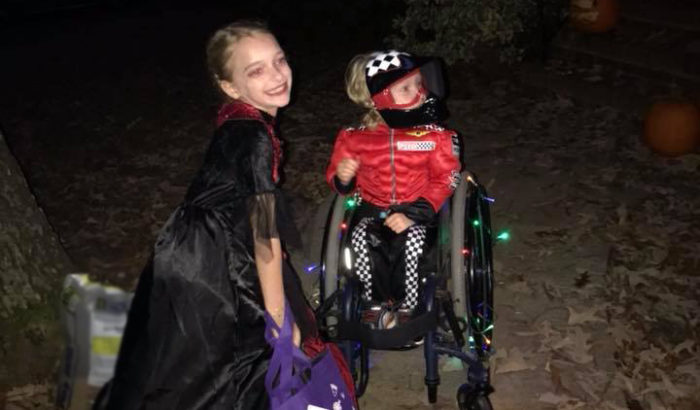
Grinning playfully, Luca Watkins zoomed around the third floor of the Children’s Pavilion during our 2017 calendar photo shoot, showing off his new mobility equipment and checking out our water-themed interactive wall display. He’d been using a dynamic stander (pictured with him in his calendar photo) for about two months. Being a curious two-year-old, he’d already mastered how to move himself around in it quickly – which kept our photographer active and entertained as he followed Luca and took pictures.
Eventually Luca’s mom, Stephanie, literally had to put the brakes on his stander to give us a better chance at capturing Luca’s smile, positive spirit and beautiful blond curls for the photo, all of which he was happy to share.
Luca has spina bifida, a birth defect of the spine that affects the muscles and movement in his lower extremities. Known for having an upbeat “never let it get you down” personality, Luca hasn’t let these physical challenges slow him down from what kids his age like to do. Since he was 18 months old, he’s used specialized equipment for mobility. Before that, he scooted around on his arms. “Luca’s never known anything different and never acted like it either,” Stephanie says. “From a very young age he began using is arms to get from Point A to Point B. It’s like he knew how he was made already.”

A complex diagnosis
Luca was diagnosed during a prenatal ultrasound. It was around Stephanie’s 18-week checkup and she was hoping to find out if she was having a boy or a girl. She’d even brought Luca’s older sister Lillian along, as gender-reveal cakes were popular at the time and they’d planned on making one for Luca’s dad. “I was told he had a very large [spinal] lesion, a massive hole in his heart, clubbed feet and no chance of walking or even surviving to term,” she says. “I was told he had a one percent chance to live and that babies with spina bifida do not survive to have fulfilling lives.”
For Stephanie, that appointment was the first step on a path of parenting that would include advocating for her child to ensure that would not be the case for Luca. Very soon after that day, their family connected with CHoR orthopaedic surgeon Dr. Victoria Kuester to begin planning the specialized care Luca would need.
Mobility is everything
Weeks after he was born, Luca received the first in a series of casts, orthotic devices and specialized ankle braces to straighten his inward-pointing clubfeet. In the coming years, he underwent several surgeries to lengthen his leg and ankle muscles and help minimize hip problems. Twice he spent many weeks in large casts that immobilized his hips and thighs to support healing after surgery. He also started physical therapy at just three months old.
For children with spina bifida, the level of their spinal cord abnormality determines if they will be able to walk, but surgery, treatment and therapy can help too. “Sometimes it’s difficult to know at the beginning what their function will be,” Dr. Kuester explains. “Therefore, the treatments for Luca’s hips, knee and feet have been performed with the goal that if he had the potential to walk then he would be in a good position to do so. And if not, that he can sit in a wheelchair well and stand and transfer. The long-term goals are to make him the most functional and independent he can be physically.”
Luca’s treatments were specifically designed to put one of his hips and knees in the right place to allow them to move well. His limbs also need to be as flexible as possible and “brace-able” to allow him to sit, stand and move more easily and they helped with this as well. “I can’t say enough about what Dr. Kuester has done for Luca,” Stephanie says. “She has helped his lower extremities to the best of her ability in order for him to have the best quality of life possible. Mobility for Luca is everything. It is how he navigates the world around him and Dr. Kuester helps him achieve it.”
Partners for life
Dr. Kuester is part of our specialized spina bifida clinic team which includes specialists in neurology, orthopaedics, physical medicine and rehabilitation, and urology. The team works closely with Luca, his family and the other medical specialists he sees to address the medical issues associated with spina bifida, support his mobility, and find ways to maximize his daily functioning and overall quality of life. They’ll continue to follow him until young adulthood, providing age-appropriate care throughout all the stages of childhood and adolescence.
Luca has also received care from other CHoR programs and medical specialists, including cardiology and nephrology. In addition to physical therapy, he began occupational and speech-language therapy programs at a young age. Having experienced digestive issues associated with physical complications of spina bifida, he also underwent a year of therapy in our feeding program to help expand the variety of foods he was willing to eat.
With such a complex medical situation, one of the things Stephanie has found so important to Luca’s care and daily life is how much his medical team listens to her input. “They know we know our kids,” she remarks. “They allow me to speak about anything that’s going on that might be pertinent to Luca’s care before diving into questions or vitals. They know I know his limitations regarding his lower extremities and allow me to assist when needing to see anything in that area. It takes time to fully explain Luca’s complex history, but they allow me to do so fully without fail. I know that the more they know about him, the better they will understand how to help him achieve a successful future and have the best quality of care.”
From homemade to hi-tech 
Exploring the world is vital for a child’s developing mind and Luca’s family and team have worked to ensure that even at a young age Luca is as functional as he can be in this regard. Luca never cared for being carried – “he’s independent,” Stephanie says – and she and her husband found it unfair for him to be forced in a stroller when he clearly wanted independence. Most insurance plans, however, don’t cover a pediatric wheelchair until a child is at least two according to Stephanie, so when Luca was 18 months old she and her husband built one for him using a Bumbo seat, lawn mower wheels and a wooden frame (pictured). “He wanted to get around and we needed to find a way for him other than his scooting on the floor with his hands,” she says.
Months later Luca transitioned to the dynamic stander which allowed him to move around in an upright position and more actively explore. Luca used the stander for a matter of months, but over time his tight inner hip muscles made it difficult for him to fit into it correctly. He’s working on loosening these muscles with daily stretches at home and in his physical therapy sessions and he now relies more on a pediatric wheelchair which Stephanie says is “amazing.” “He cruises all over the place with it. He goes to school in it, his appointments, the park (he LOVES Three Lakes Park Nature Center), and anywhere that’s easy for him to get around. With the use of his wheelchair, he’s able to be independent, free, and have every experience any other child does.”
 Good surprises
Good surprises
Luca turned 3 this past September. He attends a pre-kindergarten program at R.C. Longan Elementary school in Henrico, Va., and has graduated from his occupational or speech-language therapy programs.
“He’s done really well,” Dr. Kuester remarks. “His mom is on top of everything and advocates for him which is wonderful to see.”
Advocating for Luca has involved several roles for Stephanie – getting him to many appointments, sharing his story, building equipment and so much more. She continues to actively advocate for her son every day. A great example of this is at home in their kitchen where Luca likes to help out by setting the table (“well, the napkins and spoons”) and putting things in the trash. Stephanie encourages these types of opportunities so he can problem-solve how to use his wheelchair and hold items at the same time. It’s likely that soon he’ll be helping out with the shopping as well, as Stephanie is in the process of transitioning Luca to going to grocery and retail stores in his wheelchair, instead of sitting in the cart baskets.
With this level of support, the list of things Luca likes to do in the world – and is able to do in his wheelchair – is continually growing. He loves being outdoors: going on walks, playing catch, watching for animals or just sitting on the porch. Playing hide-and-seek with friends is a favorite activity, and sports are too – he even shot baskets in a wheelchair while in a cast (pictured). “Luca loves to just go in his wheelchair,” Stephanie adds. “He’s an average toddler who loves to get into anything and everything.”

Luca was on the “go” for Halloween this year along with the rest of the kids in his neighborhood (pictured). His wheelchair wheels were lit up with bright colorful lights for the night of fun. “Luca has surprised me in so many ways,” Stephanie reflects proudly. “I think the biggest surprise is that he never complains about his mobility. He’s happy, full of life, and never lets his mobility stop him from doing what he wants to achieve.”
The “Meet our Calendar Kids” blog series highlights children featured in CHoR’s Tid*Bits calendar. Join our mailing list to receive future issues of the Tid*Bits calendar and newsletters. We hope you’ve enjoyed getting to know Luca our featured patient for October 2017.
More about Luca – fun facts
School grade and name: Pre-K at R.C. Longan Elementary School in Henrico, Va.,
Favorite food: Spaghetti
What he likes to do for fun: Loves Mickey Mouse and outings to places like the Children’s Museum, ARC Park and Three Lakes Park Nature Center
What he likes to do at CHoR: Loves going on the elevators and visiting the interactive floor and wall displays (“We know all the floors and where all the games and displays are,” Stephanie says.)
October is Spina Bifida Awareness Month
“Most families don’t even know what spina bifida is until their child or someone they know is diagnosed with it. I was one of them until Luca was diagnosed.
I would like people to know that spina bifida comes in all shapes and sizes. We know children who can walk with or without assistance, use arm crutches, walkers or wheelchairs.
If anyone would like more information about spina bifida they can look at the Spina Bifida Association website and our local chapter website is the Spina Bifida Association of the Mid-Atlantic Region. Also, we are always looking for volunteers and sponsors to help us raise awareness and help with our local Walk-N-Roll for Spina Bifida.”
–Stephanie Rasmon, mom of Luca Watkins, age 3
